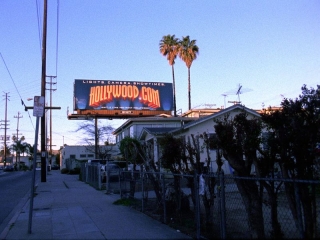Date: 31 October 2004 | Season: London Film Festival 2004 | Tags: London Film Festival
LOS ANGELES PLAYS ITSELF
Sunday 31 October 2004, at 12pm
London National Film Theatre NFT3
Thom Andersen, Los Angeles Plays Itself, USA, 2003, 169 min
A remarkable documentary about cinema, an endlessly fascinating visual lecture and an important social commentary, Thom Andersen’s love letter to Los Angeles explores the city’s representation on film. With its relentless, mesmerising montage of clips and archive footage, the film explores how the Western centre of the film industry is actually portrayed on-screen. Divided into chapters that treat Los Angeles as – amongst other things – background, character and subject, the film revisits crucial landmarks (the steps up which Laurel & Hardy attempted to manoeuvre a piano in The Music Box, explores famous buildings (the Spanish Revival house in Double Indemnity, the cavernous Bradbury Building made famous by Blade Runner), and charts the city’s ‘secret’ history through such films as Chinatown, L.A. Confidential and Who Framed Roger Rabbit. As comfortable with softcore exploitation as it is with the avant-garde, Los Angeles Plays Itself is a cinematic treasure trove that makes one think again about a city that – as a movie location – has never seemed quite as romantic or exciting as New York. Indeed, the world around you may seem more mysterious and compelling after almost three hours well spent in Andersen’s company. And you’ll definitely never refer to Los Angeles as ‘L.A.’ again. (David Cox)
Also Screening: Thursday 28 October 2004, at 8:15pm London NFT1
PROGRAMME NOTES
LOS ANGELES PLAYS ITSELF
Sunday 31 October 2004, at 12pm
London National Film Theatre NFT3
LOS ANGELES PLAYS ITSELF
Thom Andersen, USA, 2003, video, colour, sound, 169 min
Most movies are intended to transform documentary into fiction; Thom Andersen’s heady and provocative Los Angeles Plays Itself has the opposite agenda. This nearly three-hour “city symphony in reverse” analyses the way that Los Angeles has been represented in the movies.
Andersen, who teaches at Cal Arts, is the author of two previous, highly original film-historical documentaries – Eadweard Muybridge, Zoopraxographer and Red Hollywood (made with theoretician Noël Burch). A manifesto as well as a monument, Los Angeles Plays Itself has its origins in a clip lecture that Andersen originally “intended for locals only,” but as finished, it is an essay in film form with near-universal interest and a remarkable degree of synthesis. If Andersen’s dense montage and noirish, world-weary voice-over owe a bit to Mark Rappaport’s VCRchaeological digs, his methodology recalls the literary chapters in Mike Davis’s Los Angeles books City of Quartz and Ecology of Fear; no less than Pat O’Neill in The Decay of Fiction, but in a completely different fashion, he has found a way to turn Hollywood history to his own ends.
Digressive if not quite free-associational in his narrative, Andersen begins by detailing the effect that Hollywood has had on the world’s most photographed city – a metropolis where motels or McDonald’s might be constructed to serve as sets and “a place can become a historic landmark because it was once a movie location.” Andersen is steeped in Los Angeles architecture as well as motion pictures, and his thinking is habitually dialectical – the Spanish Revival house in Double Indemnity, which Andersen admires, turns up as another sort of signifier in L.A. Confidential, the movie that inspired his critique (not least because Andersen has the same irritated disdain for the nickname “L.A.” that San Franciscans have for “Frisco”).
With a complex nostalgia for the old Los Angeles and a far-ranging knowledge of its indigenous cinema, Andersen draws on avant-garde and exploitation films as well as studio products. In his first section, “The City as Background,” he wonders why the city’s modern architecture is typically associated with gangsters. (Producers may actually live in these houses, but, as is often the case in Hollywood, “conventional ideology trumps personal conviction.”) Andersen ponders the guilty pleasure of destroying Los Angeles, but he’s most fond of those “literalist” films that preserve, however inadvertently, or at least recognise the city’s geography: Kiss Me Deadly (with its extensive shooting in lost Bunker Hill) and Rebel Without a Cause (in which locations are shot as though they were studio sets).
Andersen goes on to discuss Los Angeles as a “character,” beginning with the city’s transformation, by hard-boiled novelists Raymond Chandler and James M. Cain, into “the world capital of adultery and murder.” The movie’s latter half is devoted to Los Angeles as subject, starting with the self-conscious urban legend of Chinatown and considering other movies – Who Framed Roger Rabbit, L. A. Confidential – that provide the city’s imaginary secret history. A disquisition on the on-screen evolution of Los Angeles cops in the 1990s leads Andersen to the African American filmmakers Charles Burnett and Billy Woodberry, who, in their neo-neorealism, provide the antithesis of movie mystification and studio fakery.
(Jim Hoberman, Village Voice)
Back to top
